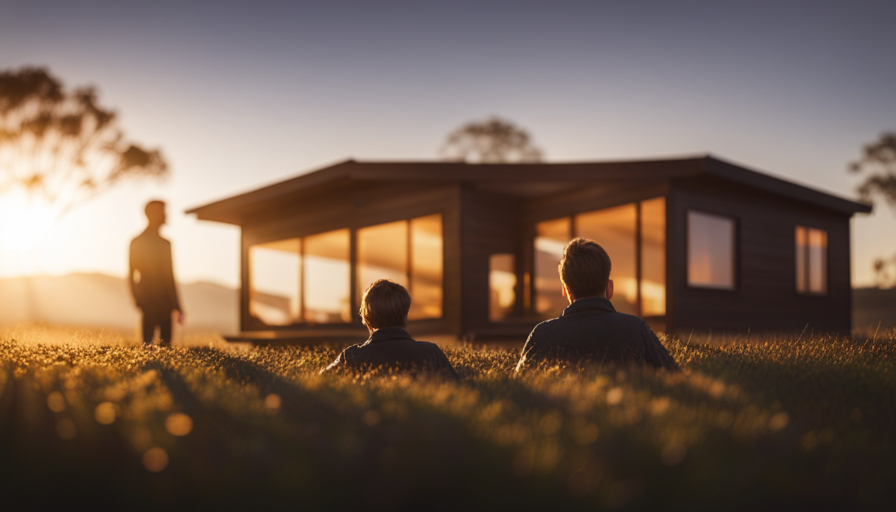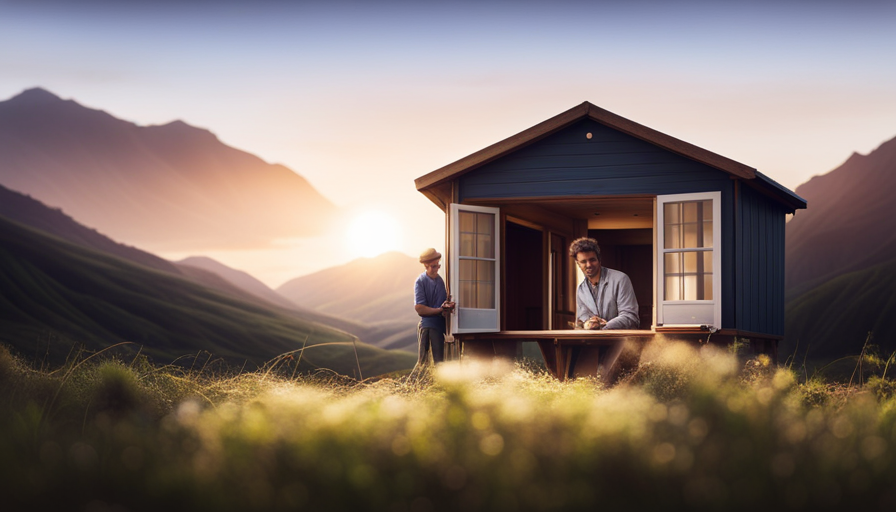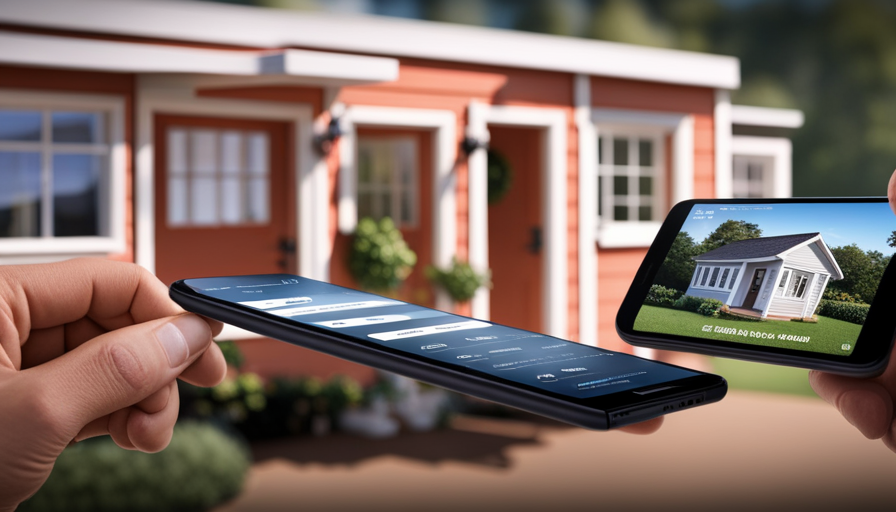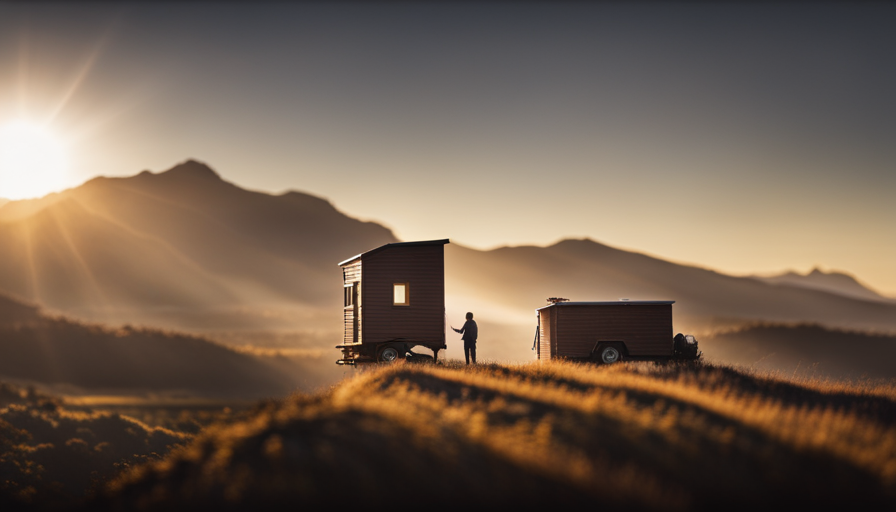Have you ever dreamed of simplifying your life by living in a charming, cute little barn house? I’m here to tell you that this lifestyle is not only possible, but also incredibly rewarding. In this article, I will guide you through the process of designing the interior of a small barn house, outlining each step.
Designing the layout of your tiny house barn is the first and most crucial step. It’s important to carefully plan the placement of each element to maximize space and functionality. From there, choosing the right materials and finishes will not only enhance the aesthetic appeal but also ensure durability and longevity.
Next, we will dive into planning the electrical and plumbing systems, as well as insulating your tiny house barn to create a comfortable living environment. Storage solutions are also a key consideration, as they will help you make the most of the limited space available.
Additionally, we will discuss creating a comfortable sleeping area, designing a functional bathroom, and incorporating natural light and ventilation. Finally, we’ll explore adding personal touches and décor to make your tiny house barn truly feel like home.
So, let’s get started on this exciting journey of building the inside of your dream tiny house barn!
Key Takeaways
- Designing the layout is crucial for maximizing space and functionality
- Choosing the right materials and finishes enhances aesthetic appeal and durability
- Clever storage solutions can maximize space and create a clutter-free environment
- Incorporating natural light and ventilation is important for a comfortable living environment
Designing the Layout of Your Tiny House Barn
Now it’s time for me to envision how I want the inside of my tiny house barn to look and feel. The key to designing the layout of a tiny house barn is space optimization. Since the square footage is limited, every inch counts.
I need to think strategically about the placement of furniture and how it can serve multiple purposes. For example, a sofa bed can provide seating during the day and a comfortable sleeping area at night.
To make the most of the space, I will also consider using built-in storage solutions, such as shelves and cabinets, to minimize clutter and maximize storage capacity. Additionally, I will explore the option of utilizing vertical space by incorporating loft areas or overhead storage compartments.
When choosing furniture, I will prioritize pieces that are multifunctional and compact in size. This will help to create an open and airy feel within the tiny house barn. I will also pay attention to the flow of the space, ensuring that there is enough room to move around comfortably.
In the subsequent section about choosing the right materials and finishes, I will explore options that further enhance the functionality and aesthetic appeal of the tiny house barn. Transitioning from designing the layout to selecting the materials and finishes will ensure a seamless and cohesive design process.
Choosing the Right Materials and Finishes
First, you’ll want to consider selecting the appropriate materials and finishes for creating the cozy and charming interior of your petite rustic dwelling. When choosing sustainable materials, it’s important to prioritize eco-friendly options that minimize the impact on the environment. Look for materials such as reclaimed wood, bamboo flooring, or recycled glass tiles. These choices not only contribute to a greener lifestyle but also add character to your tiny house barn.
In terms of finishes, you have plenty of budget-friendly options to choose from. For the walls, consider using low-VOC (volatile organic compounds) paint, which is not only environmentally friendly but also helps improve indoor air quality. Additionally, using natural finishes like lime plaster or clay paint can give your tiny house barn a unique and earthy aesthetic.
To help you better visualize the different materials and finishes available, take a look at the table below:
| Materials | Finishes |
|---|---|
| Reclaimed wood | Low-VOC paint |
| Bamboo flooring | Lime plaster |
| Recycled glass tiles | Clay paint |
By carefully selecting sustainable materials and budget-friendly finishes, you can create a beautiful and environmentally conscious interior for your tiny house barn. With the materials chosen, it’s now time to move on to planning the electrical and plumbing systems, ensuring the functionality and comfort of your cozy abode.
Planning the Electrical and Plumbing Systems
When planning the electrical and plumbing systems for my tiny house barn, I had to decide between hiring a professional or taking a DIY approach. I weighed the pros and cons of each option, considering factors such as cost, time, and my own skill level.
Ultimately, I decided to hire professionals to ensure safety and efficiency in the installation process. Additionally, I made sure to incorporate energy-efficient solutions into the design, such as using LED lighting and low-flow fixtures, to minimize my environmental impact and reduce utility costs.
Hiring a Professional or DIY Approach
If you’re not confident in your construction skills, hiring a professional to build the inside of your tiny house barn can ensure a beautifully crafted and functional space. When considering whether to hire a professional or take the DIY approach, there are a few key factors to consider.
First, think about your skill level and the complexity of the project. Building the inside of a tiny house barn involves intricate electrical and plumbing work, as well as carpentry and finishing touches. Hiring a professional can guarantee that these tasks are done correctly and efficiently.
Additionally, cost is a significant consideration. While hiring a professional may be more expensive upfront, it can save you money in the long run by preventing costly mistakes. Ensuring the safety and efficiency of your tiny house barn is crucial, and the next section will explore how to achieve this.
Ensuring Safety and Efficiency
To ensure your tiny house barn is a well-oiled machine, it’s essential to prioritize safety and efficiency.
Efficient space utilization is key when designing the interior of a tiny house barn. Consider multi-functional furniture that can serve multiple purposes, such as a fold-out bed or a dining table that can be collapsed when not in use. Additionally, utilize vertical space by installing shelves or hooks on the walls to maximize storage options.
Safety measures should also be a top priority. Install smoke detectors, carbon monoxide detectors, and fire extinguishers in strategic locations throughout the space. Ensure that all electrical wiring is up to code and properly installed by a professional. It’s crucial to have a clear emergency exit plan and easy access to emergency exits.
By prioritizing safety and efficient space utilization, you can create a functional and secure tiny house barn that meets your needs. Incorporating energy-efficient solutions is the next step in optimizing your tiny house barn’s performance and sustainability.
Incorporating Energy-Efficient Solutions
Maximize the energy efficiency of your compact living space by incorporating innovative solutions that minimize your environmental impact and reduce utility costs.
Here are three key ways to achieve this:
-
Energy Efficient Lighting: Opt for LED or CFL bulbs throughout your tiny house barn. These bulbs consume less energy and have a longer lifespan than traditional incandescent bulbs, making them a cost-effective and eco-friendly lighting solution.
-
Solar Power Integration: Harness the power of the sun by installing solar panels on the roof of your tiny house barn. This renewable energy source can provide electricity for your lighting, appliances, and heating/cooling systems, significantly reducing your reliance on the grid and lowering your carbon footprint.
-
Smart Energy Management: Implement smart home technology to control and monitor your energy usage. Use programmable thermostats, energy-efficient appliances, and power-saving devices to optimize energy consumption and reduce wastage.
By incorporating these energy-efficient solutions, you can create a sustainable and cost-effective living space.
Transitioning into the next section about insulating your tiny house barn, it’s important to consider the insulation materials and techniques that will further enhance the energy efficiency of your home.
Insulating Your Tiny House Barn
When it comes to insulating my tiny house barn, I understand the importance of insulation in maintaining a comfortable and energy-efficient living space.
I am careful in selecting appropriate insulation materials that will effectively keep the interior warm in winter and cool in summer.
Additionally, I ensure proper installation to maximize climate control and minimize any potential drafts or air leaks.
Understanding the Importance of Insulation
Insulation is crucial for maintaining comfortable temperatures inside a tiny house barn, as it can reduce heat loss by up to 75%. The benefits of insulation go beyond just keeping the space warm in winter and cool in summer. It also helps to minimize energy consumption, saving you money in the long run.
Proper insulation installation ensures that there are no gaps or leaks where air can escape, maximizing its effectiveness. Additionally, insulation helps to reduce noise transmission, creating a quieter and more peaceful living environment.
When it comes to selecting the appropriate insulation materials, it’s important to consider factors such as R-value, fire resistance, and moisture resistance. By carefully choosing the right insulation, you can ensure optimal comfort and energy efficiency in your tiny house barn.
Selecting the Appropriate Insulation Materials
To ensure optimal comfort and energy efficiency in your tiny house barn, you’ll want to carefully select the appropriate materials for insulation. When choosing insulation materials, consider eco-friendly options that minimize environmental impact. Look for materials that are made from recycled or renewable resources, such as recycled denim, cellulose, or sheep’s wool.
These options not only provide excellent insulation but also contribute to a greener and more sustainable living space. Additionally, cost-effective insulation materials, such as fiberglass or spray foam, can offer good thermal performance without breaking the bank.
By selecting the right insulation materials, you can create a well-insulated and efficient tiny house barn. This will help you maintain comfortable temperatures year-round and reduce your energy consumption.
In the next section, we will discuss ensuring proper installation for climate control.
Ensuring Proper Installation for Climate Control
For optimal climate control, it’s crucial to ensure the proper installation of insulation materials in your cozy abode. To achieve energy efficient solutions and maintain a comfortable living environment, consider the following:
-
Seal all gaps and cracks: Prevent air leaks by sealing any gaps or cracks in the walls, windows, and doors. This will help to keep the desired temperature inside and prevent drafts.
-
Use vapor barriers: Install vapor barriers between the insulation and the interior walls to prevent moisture buildup. This will help to maintain the longevity of the insulation and prevent mold growth.
-
Consider insulation types: Choose insulation materials that are suitable for your climate. For example, in colder climates, consider adding additional insulation layers or using thicker insulation materials.
By implementing these climate control installation techniques, you can create an energy efficient and comfortable living space.
Now, let’s explore how to create storage solutions for your tiny house barn.
Creating Storage Solutions
Maximize your space and enhance the functionality of your tiny house barn by incorporating clever storage solutions. When it comes to designing a small living space, utilizing vertical space and hidden storage can make a world of difference. By thinking creatively and making the most of every nook and cranny, you can create a clutter-free environment that feels spacious and organized.
One effective way to utilize vertical space is by installing floor-to-ceiling shelves along the walls. These shelves can hold books, decorative items, or even baskets for additional storage. Additionally, consider using hanging storage solutions such as hooks or pegboards to keep everyday items within reach without taking up valuable counter or floor space.
Another great option for maximizing storage in a tiny house barn is to incorporate hidden storage compartments. For example, you can build storage drawers underneath your bed or install built-in cabinets that blend seamlessly with the walls. These hidden compartments provide ample space to store clothes, linens, or any items you want to keep out of sight.
Incorporating these storage solutions will help you keep your tiny house barn neat and organized. In the next section, we will discuss how to design a functional kitchen that maximizes efficiency and minimizes clutter.
Designing a Functional Kitchen
When it comes to designing a functional kitchen for a tiny house barn, there are several key points to consider.
First, choosing compact appliances is crucial in order to maximize space while still having all the necessary amenities.
Additionally, maximizing counter and storage space is essential to ensure that everything has a designated place.
Lastly, considering ergonomics and workflow is important to create a kitchen that’s efficient and easy to navigate.
Choosing Compact Appliances
Compact appliances are the perfect solution for creating a cozy and efficient living space inside a tiny house barn. When designing a kitchen in a small space, it’s important to choose appliances that are not only functional but also space-saving. There are several compact appliance options available that can help maximize counter and storage space.
To give you an idea of the possibilities, here is a table showcasing three popular compact appliances for a tiny house barn kitchen:
| Appliance | Dimensions | Features |
|---|---|---|
| Compact Fridge | 24"W x 24"D x 60"H | Energy efficient, adjustable shelves |
| Two-Burner Stove | 12"W x 20"D | Induction cooktop, compact size |
| Countertop Oven | 18"W x 14"D x 12"H | Convection cooking, multiple functions |
These appliances are designed to fit perfectly in small spaces without compromising functionality. By choosing compact appliances, you can create a functional kitchen while still having enough room for maximizing counter and storage space.
In the next section, we will explore strategies for maximizing counter and storage space in a tiny house barn kitchen.
Maximizing Counter and Storage Space
To make the most of your limited kitchen space, get creative with clever storage solutions and make use of every inch of your countertops. Here are five tips to maximize your counter and storage space in your tiny house barn:
- Install floating shelves or hanging baskets to utilize vertical space.
- Use magnetic strips or hooks to hang knives, utensils, and other metal items.
- Utilize the inside of cabinet doors by installing hooks or small shelves.
- Invest in multi-functional kitchen tools and appliances, such as a cutting board that doubles as a colander.
- Consider using stackable storage containers and collapsible kitchenware to save space when not in use.
By implementing these creative storage solutions, you can maximize your counter space and keep your kitchen organized in your tiny house barn.
Now, let’s explore how considering ergonomics and workflow can further enhance your kitchen design.
Considering Ergonomics and Workflow
After maximizing counter and storage space in my tiny house barn, the next step is to consider ergonomics and workflow. It’s important to create a space that is not only functional but also comfortable and efficient to work in.
One way to achieve this is by incorporating ergonomic furniture, such as adjustable height desks and chairs with good back support. This will help prevent fatigue and strain on the body during long hours of work.
Another aspect to consider is workflow optimization, which involves arranging the furniture and equipment in a way that promotes a smooth and efficient flow of tasks. This can be achieved by placing frequently used items within easy reach and organizing workstations based on the tasks at hand.
By focusing on ergonomics and workflow, I can ensure that my tiny house barn is a productive and comfortable space to work in. Now, let’s move on to creating a comfortable sleeping area.
Creating a Comfortable Sleeping Area
When designing a comfortable sleeping area in a tiny house barn, it’s important to consider several key points.
Firstly, choosing the right bed size and style is crucial to ensure a good night’s sleep.
Secondly, incorporating storage solutions for bedding is essential in order to maximize space and keep the sleeping area tidy.
Lastly, enhancing privacy and comfort can be achieved through the use of curtains, dividers, or even soundproofing materials to create a peaceful and restful environment.
Choosing the Right Bed Size and Style
As you explore your options for bed sizes and styles, imagine the cozy haven you can create inside your tiny house barn. When it comes to bed frame options, there are a few key factors to consider. First, think about the overall size of your tiny house and the available space for a bed. A bed frame with built-in storage can be a great space-saving solution. Next, consider the mattress size that will fit best in your tiny house. While a standard queen or king mattress may be too large, a full or even a twin-size mattress can provide ample comfort in a smaller space. Once you have chosen the right bed size, consider the style that best fits your aesthetic. From sleek and modern to rustic and farmhouse-inspired, there are plenty of options to choose from. With the perfect bed in place, it’s time to think about incorporating storage solutions for bedding and other essentials.
Incorporating Storage Solutions for Bedding
To maximize your space and keep your bedding organized, consider incorporating storage solutions into your cozy haven. Here are three space-saving options for bedding storage:
-
Under-bed storage: Utilize the space beneath your bed by investing in storage containers or drawers that can easily slide in and out. This is perfect for storing extra sheets, blankets, or pillows.
-
Wall-mounted shelving: Install wall-mounted shelves above your bed to create additional storage space for folded bedding or decorative items. This not only adds functionality but also adds visual interest to your tiny house barn.
-
Built-in storage: If you have the option, consider incorporating built-in storage units into the design of your tiny house barn. This can include cabinets, drawers, or even hidden compartments that blend seamlessly into the walls.
By incorporating these bedding storage solutions, you can optimize your space and keep your cozy haven clutter-free.
Now, let’s explore how to enhance privacy and comfort in your tiny house barn.
Enhancing Privacy and Comfort
After incorporating storage solutions for bedding in my tiny house barn, I realized that enhancing privacy and comfort were equally important.
To achieve both, I explored various privacy solutions and comfort enhancements. One effective privacy solution was installing curtains or blinds on the windows, allowing me to control the amount of natural light and visibility from outside. Additionally, I added frosted glass or decorative window films to the bathroom window and any other areas where privacy was crucial.
To enhance comfort, I invested in a quality mattress and soft bedding, ensuring a good night’s sleep in my cozy space. I also incorporated comfortable seating options, such as a plush armchair or a small sofa, to create a comfortable and inviting atmosphere.
Now, with privacy and comfort taken care of, it’s time to move on to designing a functional bathroom.
Designing a Functional Bathroom
When designing a functional bathroom for a tiny house barn, it’s important to consider that the average person spends about 1.5 years of their life in the bathroom. With limited space, it becomes crucial to prioritize bathroom fixtures and opt for space-saving designs.
Here are three key considerations to keep in mind:
-
Compact fixtures: Investing in compact bathroom fixtures is essential for maximizing space in a tiny house barn bathroom. Opt for a small toilet, a corner sink, and a narrow shower stall. These fixtures not only save space but also provide functionality without compromising on comfort.
-
Storage solutions: Utilizing every inch of available space is crucial in a tiny house barn. Incorporate clever storage solutions such as wall-mounted cabinets, over-the-toilet shelves, and recessed niches. These additions will help keep the bathroom organized and clutter-free.
-
Multi-functional design: When space is limited, it’s important to make every element in the bathroom serve multiple purposes. Consider installing a vanity mirror with built-in storage or a showerhead with a handheld option. These multi-functional designs will maximize the functionality of the bathroom without sacrificing comfort.
Incorporating natural light and ventilation is the next step in creating a well-designed tiny house barn bathroom.
Incorporating Natural Light and Ventilation
After designing a functional bathroom for your tiny house barn, the next step is to focus on incorporating natural light and ventilation into the space. This is crucial for creating a bright and airy atmosphere that can make your tiny house feel more spacious and comfortable.
When it comes to natural light design, there are a few techniques you can use. Firstly, consider installing large windows or skylights to maximize the amount of sunlight that enters the barn. This will not only illuminate the space but also provide beautiful views of the surrounding landscape. Additionally, using light-colored paint on the walls and ceilings can help reflect and distribute natural light throughout the interior.
Ventilation is equally important in a tiny house barn, as it helps to circulate fresh air and prevent stuffiness. One effective technique is to install ceiling fans or small ventilation systems that can be easily controlled. These will help keep the air flowing and maintain a comfortable temperature inside the barn.
Incorporating natural light and ventilation techniques into your tiny house barn will create a pleasant and inviting atmosphere. With the right design choices, you can make the most of the available space and create a cozy living environment.
Now, let’s move on to the next section where we’ll explore adding personal touches and décor to make your tiny house barn truly unique.
Adding Personal Touches and Décor
To truly make your tiny house barn feel like a home, you can add personal touches and décor that reflect your unique style and personality. Personalized accents are a great way to add charm and character to your space. Consider using items that have sentimental value or that showcase your hobbies and interests.
For example, if you love traveling, you could display a collection of postcards or maps from your favorite destinations. Unique artwork is another fantastic way to infuse your tiny house barn with your personal style. Consider hanging paintings or photographs that you love and that resonate with you. You could even create your own artwork to add an extra personal touch.
Don’t be afraid to think outside the box – you could hang a tapestry, a handmade quilt, or even a collection of vintage posters. When it comes to décor, focus on simplicity and functionality. Choose furniture and accessories that serve a purpose while also adding aesthetic appeal. Opt for multipurpose pieces that can save space, such as a coffee table that doubles as storage or a bench with built-in shelves.
By incorporating personalized accents and unique artwork, you can create a tiny house barn that truly feels like home. Let your imagination run wild and have fun with the process of making your space reflect your individuality.
Frequently Asked Questions
How much does it cost to build a tiny house barn?
Building a tiny house barn: Is it worth the investment? Let’s investigate.
The hidden costs of constructing a tiny house barn can significantly impact your budget. While the initial construction costs may seem reasonable, there are additional expenses to consider. These include permits, site preparation, utilities, and interior finishing. These hidden costs can quickly add up and affect the overall affordability of your project.
So, before diving in, it’s essential to carefully evaluate whether building a tiny house barn is worth the investment.
What are the legal requirements for building a tiny house barn?
Legal considerations and zoning restrictions are important factors to consider when building a tiny house barn. Before starting construction, it’s crucial to research and comply with local building codes, permits, and regulations. These requirements may vary depending on the location, so it’s essential to consult with local authorities or a professional to ensure compliance.
Zoning restrictions may dictate the size, location, and use of the structure, so it’s important to understand and adhere to these regulations to avoid any legal issues.
Can a tiny house barn be transported to different locations?
Yes, a tiny house barn can be transported to different locations, which is one of its key advantages. Its transportability allows for flexibility and the ability to relocate as needed.
However, there are some disadvantages to consider. Moving a tiny house barn requires specialized equipment and can be costly. Additionally, the structure must be properly secured during transportation to prevent damage.
Despite these challenges, the ability to transport a tiny house barn offers the opportunity for change and adaptability.
How long does it typically take to build a tiny house barn?
When planning the construction of a tiny house barn, factors such as size, design, and complexity play a crucial role in determining the time it takes to complete. For example, a 200 square foot barn with a simple layout can be built in about 2-3 months, assuming all necessary permits and materials are readily available.
However, more intricate designs or larger sizes may take longer. It’s important to carefully consider these factors to ensure a smooth and timely construction process.
Are there any specific building codes or regulations that need to be followed when constructing a tiny house barn?
When constructing a tiny house barn, it’s crucial to adhere to specific building codes and regulations. These codes ensure the safety and structural integrity of the building. However, meeting these regulations can pose challenges due to the unique nature of tiny house barns.
For instance, issues may arise regarding minimum square footage requirements, plumbing and electrical systems, and zoning restrictions. It’s essential to consult with local authorities and professionals to navigate these challenges and ensure compliance with building codes for tiny house barns.
Conclusion
After completing the construction of my tiny house barn, I couldn’t be happier with the end result.
Every step of the process was worth it, from designing the layout to choosing the materials and finishes.
One interesting statistic that caught my attention during this project was that tiny houses use approximately 80% less energy for heating and cooling compared to traditional homes. This not only saves money but also has a positive impact on the environment.
I’m proud to have built a sustainable and cozy living space that meets all my needs.
Hi, I’m Emma. I’m the Editor in Chief of Tiny House 43, a blog all about tiny houses. While tree houses are often associated with childhood, they can be the perfect adult retreat. They offer a cozy space to relax and unwind, surrounded by nature. And since they’re typically built on stilts or raised platforms, they offer stunning views that traditional homes simply can’t match. If you’re looking for a unique and romantic getaway, a tree house tiny house might just be the perfect option.










